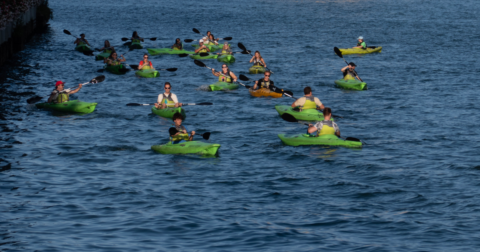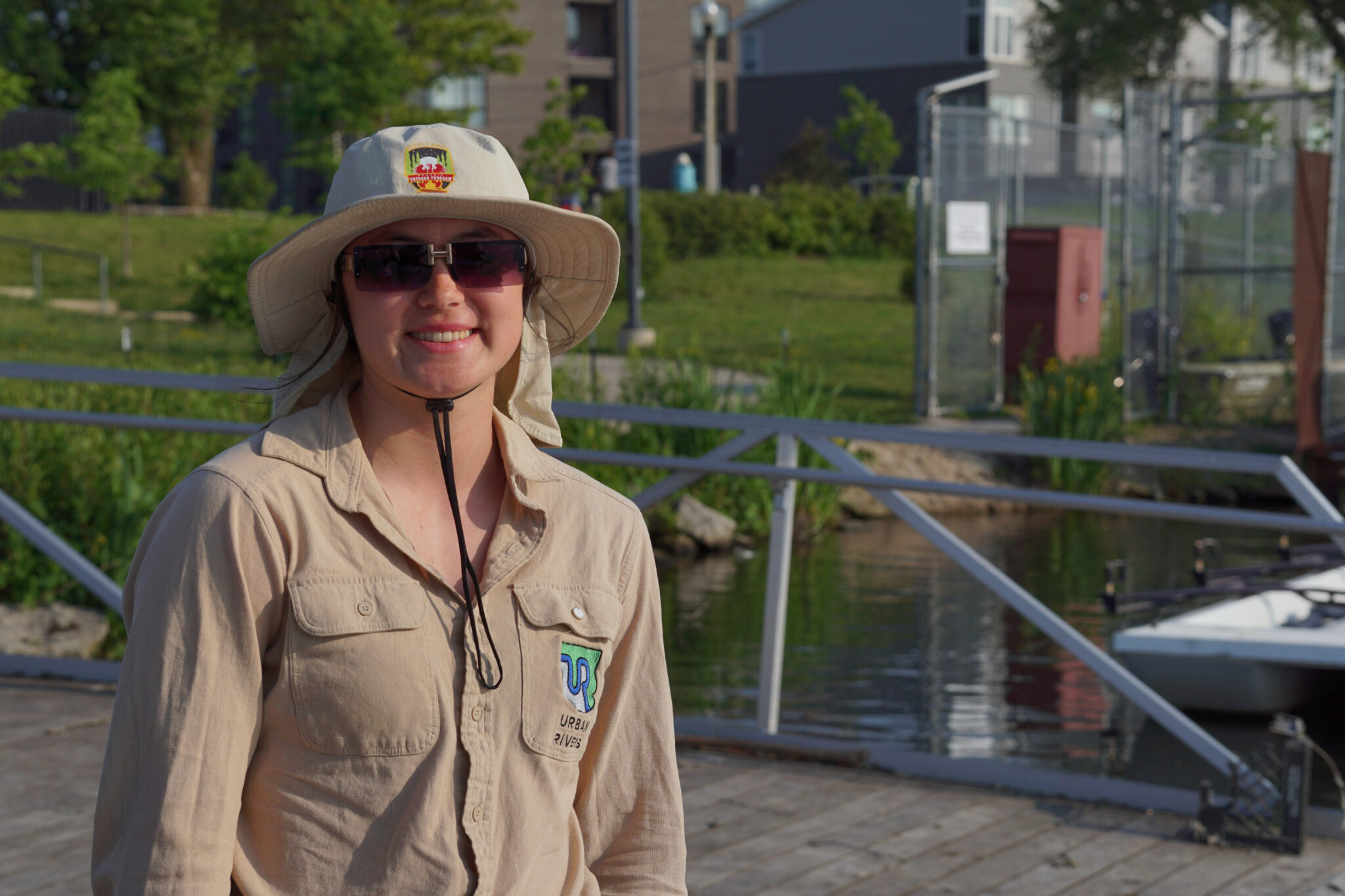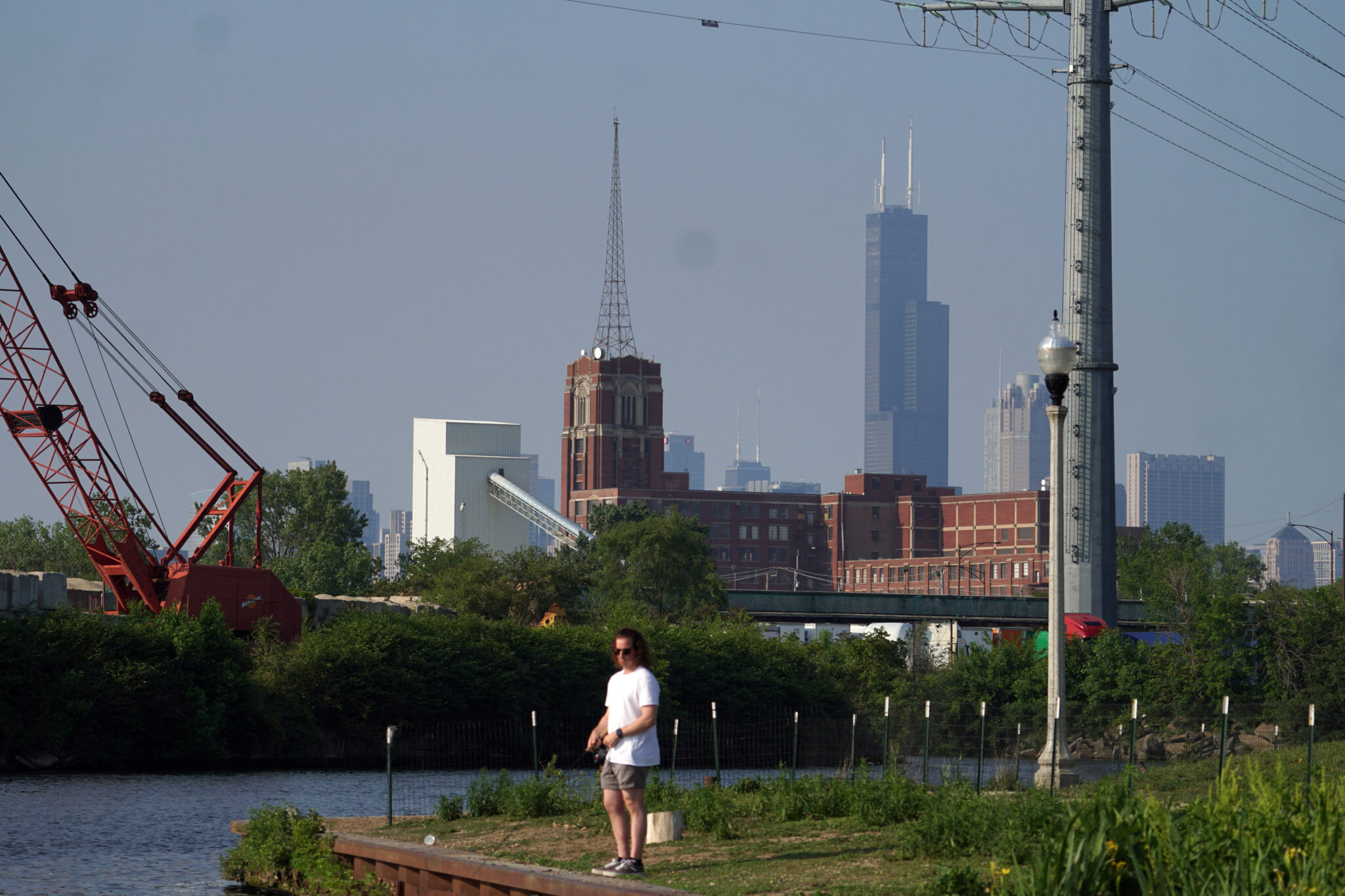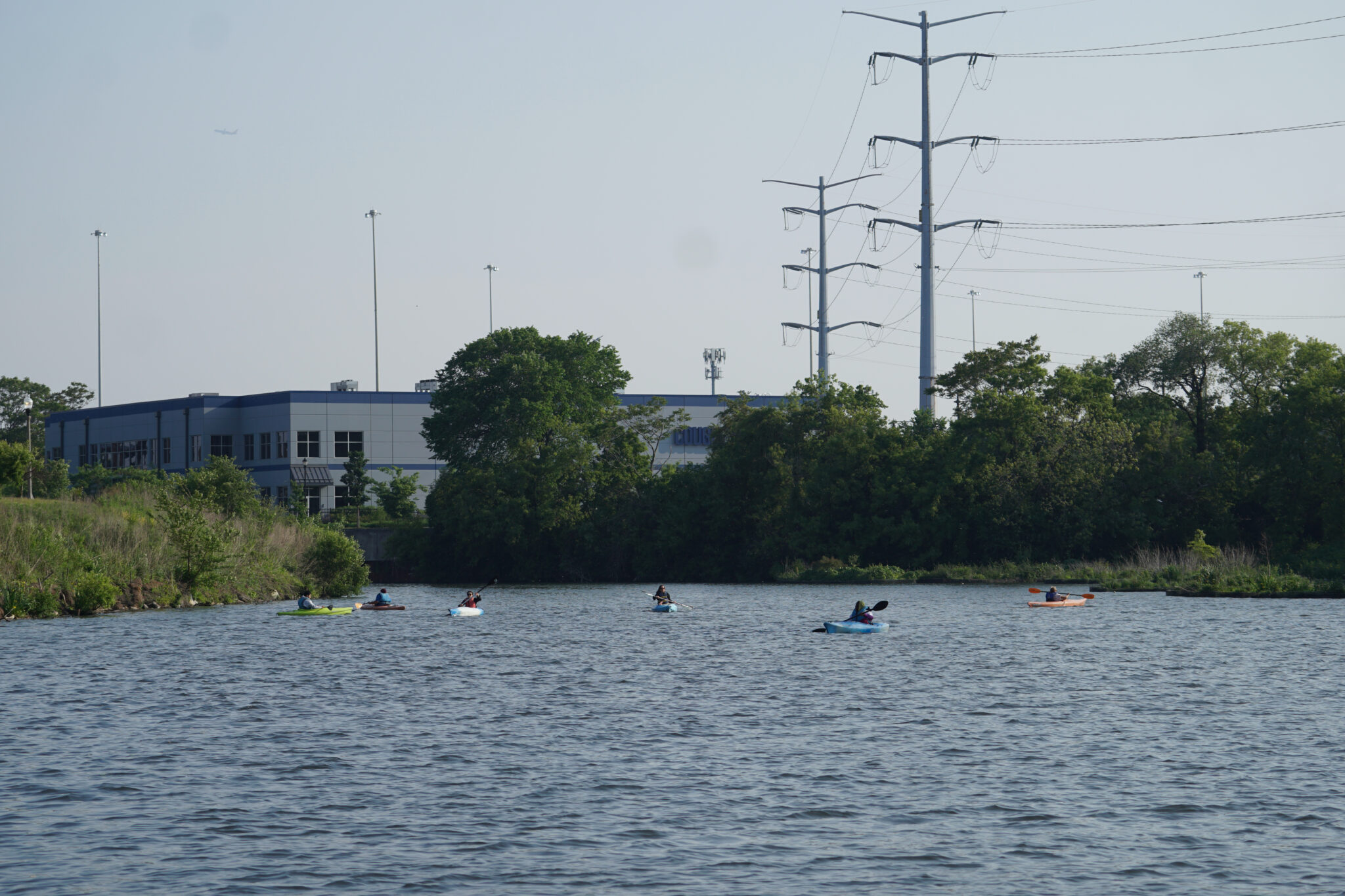Explainer
How Overconsumption Affects the Environment and Health, Explained
Climate•12 min read
Feature
Once the home of the massive Union Stock Yards, the infamous dumping ground is now a popular recreational area.


Words by Ethan Freedman
Summer days are a precious resource in Chicago, especially in June, when memories of the city’s endless, gray winter are still fresh. On one warm Friday afternoon early in the month, a small crowd of Chicagoans could be found enjoying the weather at Bubbly Creek, a branch of the Chicago River that was once the dumping site for the Union Stock Yards, a sprawling meatpacking plant that processed millions of animals every year.
A century ago, the river here was full of decaying blood, animal parts and organs, creating a noxious, bubbly stew that gave the creek its name. Though the stock yards are now long gone, raw sewage dumping and other industries have also contaminated the water over the years — and Bubbly Creek is still contending with the legacy of all that pollution.
But thanks to cleanup efforts across the Chicago River system, Bubbly Creek is no longer a fetid mess. During the summer, Urban Rivers, a local nonprofit, hosts community days at a nearby park, loaning out kayaks so people can paddle down the creek. People like Sage Rossman, the nonprofit’s community outreach and programs manager, along with staff from Chicago’s Shedd Aquarium, are on hand to help people get in and out of the boats, and teach them about the river’s wildlife.
That day in June, Rossman had gone out paddling in Bubbly Creek and spotted, among other things, a green heron, a black-crowned night heron, a cormorant, multiple species of swallow, ducks, geese, gulls and turtles. She also said she saw “evidence of beavers” — recently, a beaver living in this area made the news and was dubbed “Ida Beav Wells,” after the city’s most famous investigative journalist, Ida B. Wells.
“She roams, she chews a lot of bark from the trees around here and she has recently captured the hearts of Chicagoans,” Rossman says.

Cleaning up Bubbly Creek enough to coax this wildlife back and make the water safe for people to go kayaking took decades of halting progress, and still isn’t complete. But this former dumping ground for the meat industry is also on the leading edge of a riverine renaissance in Chicago — one that is transforming once-polluted sacrifice zones into natural, ecological corridors accessible for the public to enjoy.

In 1673, Louis Jolliet, a French Canadian explorer, and Jacques Marquette, a French Jesuit missionary, led by an Indigenous tribe, were the first Europeans to cross the “Chicago Portage.” The portage was a muddy, often flooded, trail system between the Des Plaines River, part of the Mississippi River network, and the Chicago River, which was connected to Lake Michigan. Even early on, Jolliet and Marquette realized how valuable the portage site would be if it could be traversed by boat, connecting the Great Lakes to the Mississippi. In 1848, that feat was achieved with the opening of the Illinois and Michigan (I&M) Canal, which created a three-way aquatic crossroads between the canal, the south branch of the Chicago River and a small tributary that would soon be known as Bubbly Creek.
Centuries ago, the area around Bubbly Creek would have been a “meandering prairie stream,” home to wildlife like black bears, wolves and elk, says Margaret Frisbie, the executive director of the nonprofit Friends of the Chicago River. But after the I&M Canal was built, this nexus of waterways quickly became an important transportation corridor for goods traveling across the country. The Union Stock Yards opened less than two decades later, as a collection of smaller stockyards in the city merged into one large meatpacking operation at Bubbly Creek — in many ways, one of America’s first factory farms.
The stock yards dumped their waste into the creek through gravity-fed ditches and canals connected into Bubbly Creek, says Mark Hauser, education manager at Friends of the Chicago River. “It would just slowly flow downstream, and it created this oil on the surface, and foam and a coating of dust,” Hauser says. “You could hardly even tell it was a river, it moved so slowly.”
Bubbly Creek became nationally famous in 1906, after Upton Sinclair published “The Jungle,” his novelized exposé of the horrific working conditions at the Union Stock Yards. Sinclair wrote that “the grease and chemicals that are poured into it [Bubbly Creek] undergo all sorts of strange transformations, which are the cause of its name; it is constantly in motion as if huge fish were feeding in it, or great leviathans disporting themselves in its depths. Bubbles of carbonic acid gas will rise to the surface and burst, and make rings two or three feet wide.”
Chicago did have an anti-pollution ordinance on the books in the 1800s, according to Libby Hill, author of “The Chicago River: A Natural and Unnatural History.” But, Hill wrote, “the stockyards powerbrokers were influential, united, wealthy, and fiercely independent; the ordinance was not enforced. They continued to pour unwholesome substances into the river.”
The Union Stock Yards have not been the only source of pollution in Bubbly Creek, let alone the rest of the Chicago River. Raw sewage was often dumped directly into the river, at first because sewage wasn’t treated at all and then because the city’s combined stormwater/sewage system would overflow in heavy rain. In addition, other industries have contaminated the creek with chemicals over the years, Frisbie says.
But around the start of the 20th century, Bubbly Creek’s fortunes started to rise. After “The Jungle” was published, the stock yards faced more scrutiny from the public, Hauser says. Around this time, Chicago also got serious about preventing pollution, and water treatment plants began to open to clean the city’s sewage before it reached the river. Raw sewage would still overflow into the creek when heavy rain overwhelmed the system, but even that became less common after the 1980s, when the city’s expansive network of overflow-prevention tunnels and reservoirs started to come online.
In 1971, as new refrigerated trucks and highways spread out the meat industry, the Union Stock Yards closed — and one year later, the Clean Water Act was passed, helping to clean up rivers and other polluted waterways across America.
In many parts of the country, the meat industry is still polluting waterways. Alexis Andiman, a senior attorney at the nonprofit Earthjustice, says slaughterhouses and rendering plants are some of the leading industrial dischargers of phosphorus and nitrogen pollution in the country. This pollution can cause harmful algal blooms that kill wildlife and make water unsafe to drink. Earthjustice notes that more than 60 million Americans live near waters affected by slaughterhouse pollution, with a disproportionate impact on people of color and low-income communities.
The Environmental Protection Agency (EPA) has set some limits on pollution from slaughterhouses and rendering facilities. But Andiman noted that many of those standards haven’t been updated in decades — and currently, the EPA has published the standards for about three percent of facilities that directly discharge their waste into waterways. Other facilities send their water to local water treatment plants, which can’t always handle the level of pollution the slaughterhouses send their way, Andiman says.
The EPA is expected to release updated standards for slaughterhouses and rendering facilities by the end of August, including new regulations on some indirect dischargers. According to Earthjustice, the agency’s preferred option for new standards would cut nitrogen and phosphorous pollution from slaughterhouses and rendering facilities by about 15 percent — but one of the alternative options they put forward would cut that pollution by a full 85 percent. The proposed regulations also include new restrictions on other pollutants, such as suspended solids and oil and grease. When asked for comment, the EPA said it “anticipates signing a final action by August 31, 2025, consistent with the requirements of a consent decree.”
Bubbly Creek’s problems haven’t gone away, either. The creek still sometimes bubbles as organic material decays on the riverbed, though sources were divided on whether they believed that organic material was decades-old meatpacking waste or more recent stuff, like sewage. (Hauser did say that if you were to dig into the bottom of the creek, you’d likely still find bones.) The Army Corps of Engineers has released a plan to cap Bubbly Creek’s bed with sediment to trap the pollution underneath and restore some of the stream bank, Frisbie says, but that plan is currently on hold due to legal liability issues.
In addition, while the sewer system will still overflow every once in a while, industrial buildings can still be found along the banks of the Chicago River and warehouses now cover the spot where the Union Stock Yards once sat. Nearby neighborhoods, many of which are home to working-class and immigrant communities, are still vulnerable to pollution. Ironically, some of these neighborhoods have also been worried about gentrification pushing out residents.

Protecting the Chicago River required a mindset change among Chicagoans. For decades, the city considered the river basically part of the sewage system, Frisbie says. “Literally the name, the Chicago Sanitary and Ship Canal, reflects the idea that this was part of the sewer system and that was okay.”
In the past few decades, however, Chicago has started to treat the river much like it has long treated its beloved Lake Michigan — like a natural body of water to be enjoyed and protected. In the downtown Loop, restaurants and lawns now line a riverwalk, built in the 2000s. On the city’s North Side, Urban Rivers has created the Wild Mile, a network of floating wetlands and pathways that hosts wildlife, art exhibitions and community events.
In many ways, those changes haven’t really reached the southwest corner of the river, where Bubbly Creek is located, says Rachel Havrelock, who directs The Freshwater Lab at the University of Illinois Chicago. That’s perhaps unsurprising, as the South Side is more historically marginalized and lower-income than many parts of downtown and the North Side. Rossman, of Urban Rivers, says the south branch of the Chicago River has been disproportionately affected by industry and physically isolated from the surrounding communities. “It’s also been really gross for a really long time, so there’s huge psychological and physical barriers to using these riverside green spaces,” Rossman says.
But without a doubt, Bubbly Creek is less gross than it used to be — and many river advocates are fighting to bring Chicago’s newfound love of the river to this corner of the city. During the community day in early June, plenty of people were kayaking up and down Bubbly Creek, past some floating wetlands Urban Rivers installed a few years ago.

Erin, a Bridgeport resident who went kayaking that day, was aware of the pollution in the river but went kayaking anyway, and spotted some birds swooping over the water. Three people with the Pilsen Environmental Rights Reform Organization (PERRO), a grassroots group from the nearby Pilsen neighborhood, were also on hand to encourage people to take advantage of the free kayaking. Nearby, a woman and two young boys were fishing off the docks, and a rowing team sliced through the water in perfect unison. A few blocks to the south, a bald eagle was perched on a bare tree, on a branch stretching out over the water from the greenery along Bubbly Creek’s bank.
Bubbly Creek is “cleaner and wilder than people realize, right? And tons of people use it,” Frisbie says.
“In the same way that it concentrated so many elements of historic pollution and industry, and poor treatment of human beings and animals, it’s the same,” Frisbie adds. “It can be the same for hope and change as much as it was for destruction.”